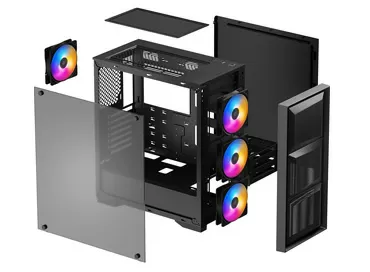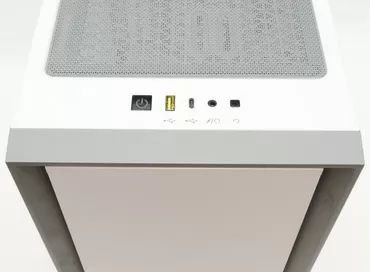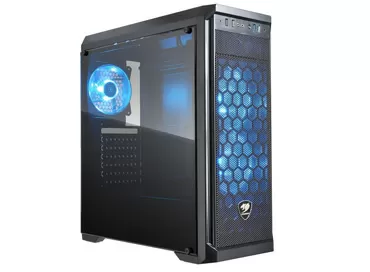AeroCool Quantum Mesh - review of compact PC Case
Today we will introduce you to AeroCool Quantum Mesh. To begin with, this model is available in three versions, which differ in the complete fans. We have the second version with three Fixed RGB fans. This model is distinguished by its rather compact size and a large number of installation places for 120 and 140 mm fans. At the same time, this case can accept an ATX motherboard and a modern powerful video card.
The introduction begins with the packaging, although there is nothing interesting here – the usual cardboard box with a monochrome design. The equipment is quite modest, it includes only a user manual and a standard set of fasteners and ties, and all this is inside the case, so we will see it in the photos a little later.
Let's start with the dimensions, they are 206x450x360 mm. That is, in height and width it is similar to the average ATX case, but in length it is slightly shortened. We'll talk about the inner space a little later, but for now we'll talk about the exterior. Many modern cases are divided into two volumes, in AeroCool Quantum Mesh this division is also used in the design. The case looks like two sections connected together – the lower one for the power supply and storage devices, and the upper one for the motherboard and other components. Even the side wall, made of tempered glass, only slightly extends to the lower section.
The front panel is partially covered with a fine mesh mesh. Through it, you can see two pre-installed fans with RGB lighting. The front panel, by the way, is very easy to remove and we get access to the front fans. The buttons and connectors are on top, there are already a pair of USB 3.0 ports and one USB 2.0, and of course the usual "Power" and "Reset" buttons, and a pair of 3.5 mm audio ports for connecting headphones and a microphone. But what we were a little confused – the absence of a dust filter on the top panel. We see "bare" seats for a pair of 120 mm fans that are not covered by a filter. Of course, most of the upper fans are set to blow, but in the off state, dust will certainly get into the housing through the perforation.
At the back, the case looks quite standard – the lower location of the power supply, a 120 mm fan on the back wall (the same as the front ones - with RGB illumination). The only thing that catches your eye is the turning corner that fixes the expansion boards. But do not worry – the possibility of attaching the boards to standard screws is left. So to speak, a double mount is obtained. Although in fact, this corner is forced to be installed, because the ports and expansion cards are displayed in the plane of the back panel, which means that you need space to install the boards (the same video card), and that there is no hole-such a rotary "door"is made. Well, now let's look at the inner world of the case, for this you need to remove the side panel made of tempered glass, which is attached to four screws with a large knurled head. They are easily unscrewed by hands, no tool is needed.
The space for the motherboard is very compact, especially in width. The motherboard of the ATX format fits almost in the butt-only the extreme right holes for laying cables remain open, and at the same time two seats for 2.5” drives will be blocked. If you install a miniITX card, the seats will be available. Unfortunately, the holes for laying cables do not have split plugs. But on the casing of the lower section, you can install as many as two fans that will additionally cool the video card. But we'll talk about this later.
Now let's look at the space "on the other side of the motherboard". The second side cover is the simplest, metal, without vibration isolation. There is very little space for laying cables, and the most annoying thing is that there is no possibility to install 2.5 " drives. From the "amenities", all you can be content with is a small basket in which you can install 2x2. 5"/3.5"HDD / SSD drives. What is nice – the basket can be removed, and then there will be more space for the power supply and cables. The basket is fixed with two screws with large heads, they are accessible from the bottom. Again, it is surprising that there is no dust filter under the power supply installation site. In total, there is not a single dust filter in the housing.
Let's talk about numbers. In AeroCool Quantum Mesh, you can install a CPU cooler with a height of up to 158 mm, and a video card with a length of up to 297 mm (if you do not install CBO and fans on the inside). The metal thickness of the chassis is 0.5 mm. In total, ten (!) 120 mm fans can be installed in the housing. Of which three are already pre-installed (if we talk about versions v2 and v3). However, it is not entirely clear how effectively the fans under the video card will cool, because in fact the air intake will be carried out through the front panel, passing in a zigzag along the inside, skirting the basket for hard drives. In general, the effectiveness is questionable. As for the SVO, it is possible to install models with a radiator of 240/280 mm as much as possible (and that is, size restrictions, they are indicated on the website). Well, we have already talked about the drives – here, too, you will not run away, although objectively, even in a gaming system, one fast NVMe drive of the M format is enough.2. But if you want to put another say 2.5 " SSD or a regular hard drive (for multimedia) - the opportunity will be.
Now a few words about the available versions. The v2 version that we have on the test is equipped with unmanaged fans with unmanaged lighting. They are connected with a regular MOLEX connector (pass-through), and therefore it is impossible to adjust the speed or synchronize the backlight with other devices. But if this point is important to you-look for the v3 version, there are fans with controlled illumination. And if you already have a set of fans, then look in the direction of v1 – there the price is even lower and only one ordinary black 120 mm fan is included.
Conclusions
The AeroCool Quantum Mesh-G is actually a great example of the balance between size and capability. It is noticeably more compact than the usual ATX case, but offers everything you need for a game build – the ability to install a whole pack of fans, a water cooling system, a long video card, and even a powerful long power supply (if you sacrifice a basket for HDD/SSD). Among the disadvantages, we note the small number of seats for storage devices and the complete absence of dust filters. But they are also leveled by the chic price, this is a really great offer.
Lutovinov Maxim (aka. Kok)
05/02.2021













